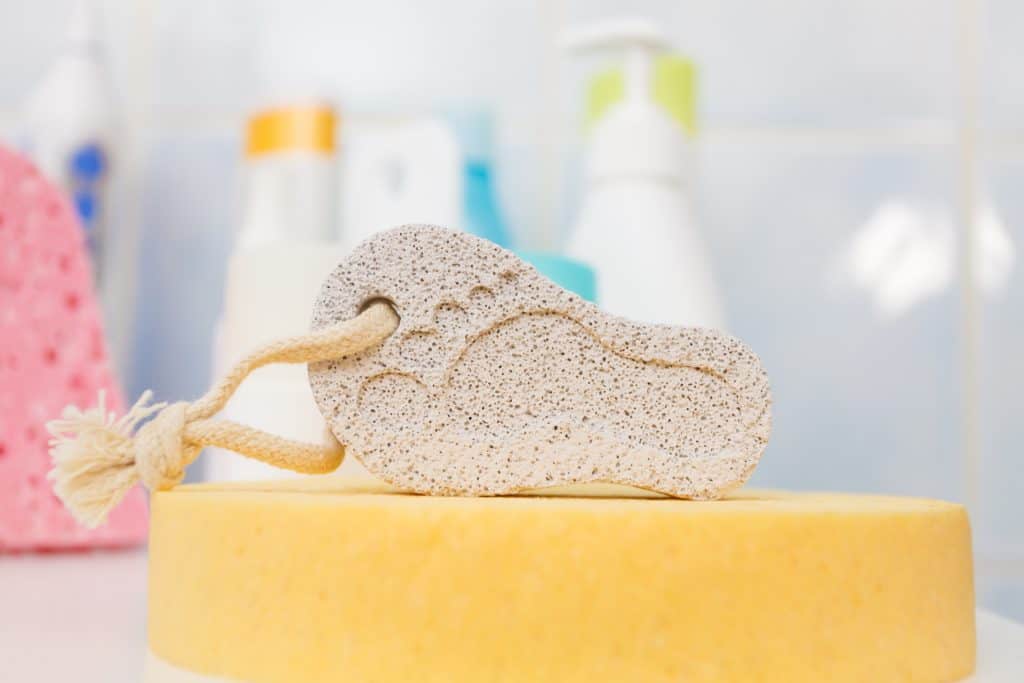
How to Use a Pumice Stone
Pumice stones are formed when volcanos are erupted. Although it’s a stone it’s really lightweight and looks like foam.
Because of its abrasive properties it can be used to exfoliate the skin by removing dead and dry skin cells from your body parts such as knees and elbows.
It will not only clear your skin but it will make your skin softer and smoother as well.
Furthermore, you can use it for removing scrapes of dry skin from your heels.
It can be used to get rid of ingrown hairs and body hears as well but make sure to try to remove stronger hairs with it since it can remove only small and weak ones.
Its true that it’s a really great product to get rid of dirt from your skin but you shouldn’t overuse it or you will damage your skin and you may face some problems like bleeding, brushing, or infections.
Avoid using it often especially if you suffer from skin disorders or diabetes. People with diabetes are more likely to damage their skin.
Exfoliating With a Pumice Stone
 Soak the area you want to smooth in warm water.
Soak the area you want to smooth in warm water.
Typically, this will be the callused part of the feet. Your heels may require special attention, as they tend to produce a hardened layer of callused skin that can turn scaly or crack. Exfoliating your elbows may also be wise, so check there for hardened and decaying skin deposits. When soaking, attempt to soak for at least five minutes before using the stone.
- To soak your feet, fill a bowl with the warm water and sit as you place your feet in the water; let your feet float some to keep pressure off while also covering the entire foot.
- When working on other parts of the body, we recommend that you do so after a shower.
It is best to wait a few minutes before applying the stone after a soak.
When exfoliating, it is best to work when your skin is soft. Therefore, as you prepare, be sure to check on the feel of your skin. Only begin applying the stone when it is sufficiently softened.
- Wet the stone. Before you start, there is one final step to the process, and that is dampening the stone prior to use. This allows the stone to gently glide over the skin instead of catching onto it, which would cause discomfort.
- Rub the stone gently over the calloused area. To exfoliate properly, use a circular motion as you begin scraping off the dead skin. As long as the skin is properly softened, this should be an easy enough process. Continue until you reach the fresh skin underneath the callus.
- Be sure not to press to hard on the skin, as you may end up damaging the fresh skin underneath. As long as the callus is softened up beforehand then a light pressure will get the job done.
- When working on your feet, try to pay special attention to the heel and the side of your toes. There may be other problem areas so be thorough in your search.
- Rinse and repeat. While exfoliating, take periodic breaks to wash the area away and look to check on your progress. If you still see dead bits of skin then you still have some work ahead of you.
- Unfortunately, one drawback of using a pumice stone is that it will wear over time, so when exfoliating you may need to turn the stone over to a fresher side. To keep your stone in working order be sure to rinse off the stone after every use.
Dry and moisturize your skin.

After you are finished with the pumice stone, it is best that you pat the skin dry with a clean towel, then coat the area with a moisturizer.
- Different oils such as coconut, almond, or body lotion are all great options for moisturizing the skin after exfoliating.
- Repeat as required, but be sure not to overdo it. You don’t want to damage fresh skin.
Caring for your Pumice Stone
- Scrub it after use.
After every use the dead, dry skins cells, corns, calluses and dirt will get stuck in the pores of the pumice stone. So do not forget to wash them properly after every use.
You can use a brush to get rid of the build-up of the dead skin in the stone. Make sure water is running through it, this way the stone will be cleaned thoroughly.
Use soap or put it in the boiling water for best results.
2. Dry it Properly
After cleaning it properly do not forget to dry it, this will help you prevent bacteria growing in your stone.
Keep it in sunlight, hang it and let it dry properly after that it will be ready to use again.
Boil it if necessary.
One of the benefits of using a stone as a tool is that they are often quite sturdy, and in our case, you can actually boil your stone to ensure that it is properly sanitized. To accomplish this, bring a pot of water to a complete boil, and carefully drop the stone in (avoid the splash!), and allow it to boil for five minutes. To retrieve it, use as pair of tongs to take it out of the water, then set it down to dry.
- Ideally, you’ll want to boil the stone every two weeks if you use it often.
- Bleach can be added to the cleaning process if you happen to get the stone exceptionally dirty.
Replace the stone as it wears down.
Pumice stones are inexpensive and can be found at any store that sells beauty supplies. Conversely, while stones are exceptionally strong tools, they can be worn away with use. Pumice is unfortunately one of these such stones, and thus, one must replace it after it gets too small to use.
Are there any precautions I should take when using a pumice stone?
Yes, there are several precautions you should take when using a pumice stone:
- Avoid Using on Sensitive or Irritated Skin: Pumice stones can be abrasive, so avoid using them on sensitive or irritated skin, including sunburned or recently shaved areas.
- Use Gentle Pressure: Apply gentle pressure when using a pumice stone to avoid damaging the skin.
- Keep the Stone and Skin Wet: Always use a pumice stone on wet skin and keep the stone moist to prevent abrasion.
- Test on a Small Area First: Before using a pumice stone on a larger area, test it on a small, inconspicuous area of skin to ensure you don’t have an adverse reaction.
- Don’t Share Your Pumice Stone: Pumice stones can harbor bacteria, so it’s best not to share them with others.
- Replace When Worn Out: Replace your pumice stone when it becomes smooth or worn out to maintain its effectiveness and avoid damaging the skin.
- Follow with Moisturizer: After using a pumice stone, apply a moisturizer to hydrate the skin and prevent dryness.
What should I do if my skin becomes irritated after using a pumice stone?
If your skin becomes irritated after using a pumice stone, follow these steps:
- Stop Using the Pumice Stone: Discontinue use of the pumice stone immediately to prevent further irritation.
- Rinse the Area: Gently rinse the irritated skin with lukewarm water to remove any remaining pumice dust or debris.
- Apply a Cool Compress: Apply a cool, damp cloth or compress to the irritated area to help soothe the skin and reduce inflammation.
- Avoid Scratching or Rubbing: Do not scratch or rub the irritated skin, as this can worsen the irritation.
- Moisturize: Apply a gentle moisturizer to the affected area to help hydrate the skin and restore the skin’s barrier.
Exploring Other Uses
Use it to remove hair.
In ancient times, the Greeks used to use pumice as a way to gently remove hair from the body; this method is still quite effective to this day. To remove hair on your body with pumice, first soak your skin in a bath or shower. Once it is soft and heated, exfoliate. Wet the stone first, then gently rub for about 30 seconds to completely remove the hair from the area.
- If you Pumice the hair on your skin it is like you to shaved it, in that the hair is removed close to the skin, and does not it out.
- Generally there shouldn’t be any pain, so if you are experiencing any then you may want to make sure that you aren’t pressing too hard.
Use Pumice to remove pills from clothing.
The physical makeup of the stone is suited quite perfectly for picking up and disposing of pills that happen to attach to your clothing. To do this, you’ll want to lay out your clothes on a flat surface and press the stone down on the fabric with a gentle grip. As you move the stone in a circular pattern, you should start to see the pills disappear from the cloth. If you press too hard, you can actually damage the fibers.
Finally, use it to clean your toilet.
If you have copper rings building up around your toilet, they can be removed by first putting on a pair of nonporous cleaning gloves, and then taking a pumice stone in hand and rubbing the stone on the dirty area.
- If the stain is particularly stubborn, a cleaning agent can be added.
- Obviously you will want to keep your body stones separate from stones you use for household cleaning.



